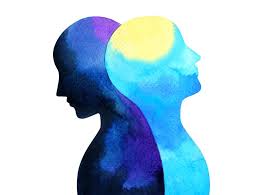By Hailey Maxwell

What Is Bipolar Disorder, Actually?
Bipolar disorder, also known as manic-depression or major affective disorder, is found in approximately 4 percent of the adult human population (Comer & Comer, 2018). There is a strong biological basis for this disease, including a genetic predetermination towards developing it. The risk increases to up to 10% if a close relative has the disorder. Among identical twins, the concurrence is between 40 and 70%. Additionally, children of men who were above the age of 40 at the time of conception are 6 times more likely to develop the disorder, which is thought to be because as men age, they have more mutations in their sperm (Comer & Comer, 2018). It is not known how many genes impact one’s likelihood of developing bipolar disorder. Many genes have been found to, in combination, increase one’s risk. Genes on 12 chromosomes have been linked to bipolar disorder (Comer & Comer, 2018).
The Genetics of Bipolar Disorder
A specific gene involved in bipolar disorder is GRM7, which codes for proteins at the receptor sites for the neurotransmitter L-glutamate, an important excitatory neurotransmitter in the central nervous system (Jun et al., 2014). The mutation in GRM7 that is tested for in genetic testing is a deletion that affects the structure of certain neurons, preventing them from receiving the neurotransmitter glutamate (Escamilla & Zavala, 2008). This prevents these neurons from firing properly.
The best-known genetic test for bipolar disorder is the Autism spectrum/hyperactivity/bipolar disorder, GRM7 related test. The test costs $399. It tests for the deletion or duplication of the gene (Doheny, 2008). However, there are so many genes involved in bipolar disorder that this one test will not be very informative as to one’s risk of developing the disorder. When considered along with race and family history, the results of the test are more informative. The group for which the test is most informative is white people of Northern European ancestry who have a family history of bipolar disorder. If the test comes back positive, this group is 3 times as likely to develop the disorder (Doheny, 2008). However, when considering that the rate among the general population is only 4%, an increase by a factor of 3 only raises the risk to 12%.
Should You Get Tested?
My recommendation would not be to get this, or any other, test for bipolar disorder. There are too many genes involved in the disorder for any one to be able to make a significant difference in the risk of developing the disorder and there is no test that can test for enough of the genes to be a good indication of whether someone will develop it. Even if this were the only gene that contributed to this disorder, a positive result on the test only marginally increases one’s risk. Even if the test were free, it would still not be recommended, but for the price of $400, I do not suggest taking this test. Instead, if you are concerned about your mental health, treat yourself well. Avoid stress, caffeine, and alcohol or other drug use. Exercise, sleep and eat well, and keep a consistent schedule (Healthwise Staff, 2018).
I Got Tested. Now What?
If you decide to go through with the test and you test negative, you do not know anything more about your risk of developing bipolar disorder. You may or may not have a mutation in a different gene that increases your risk. If you test positive, do not be overly concerned. Your risk of developing the disorder is still very low and the odds are that you will not suffer from bipolar disorder at any point in your lifetime. If you are still concerned that you will develop bipolar disorder, it is best to reduce your stress. Other than biological causes, stress is the largest agitator of bipolar disorder (Comer & Comer, 2018). It is also recommended to reduce alcohol and other drug use, as many of these substances heavily impact one’s moods and can potentially influence the development or treatment of a mood disorder.
It is suggested that you share the results of this test with your therapist, especially if you are in treatment for major depressive disorder. Bipolar disorder is often misdiagnosed as major depressive disorder when the patient has not yet had a serious manic episode. Sharing with your therapist that you are at heightened risk for bipolar disorder is recommended so that he or she may keep a closer eye out for manic behaviors and be quicker to treat them if they appear.
Sources:
Comer, R. J., & Comer, J. S. (2018). Abnormal psychology.
Doheny, K. (2008, June 4). At-Home Bipolar Disorder Test: Accuracy, Diagnosis, and More. Retrieved November 13, 2019, from https://www.webmd.com/bipolar-disorder/features/at-home- bipolar-test-help-or-hindrance#1
Escamilla, M. A., & Zavala, J. M. (2008). Genetics of bipolar disorder. Dialogues in clinical neuroscience, 10(2), 141–152.
Healthwise Staff (2018, September 11). Bipolar Disorder: Preventing Manic Episodes. Retrieved from https://www.healthlinkbc.ca/health-topics/ty6584.
Jun, C., Choi, Y., Lim, S. M., Bae, S., Hong, Y. S., Kim, J. E., & Lyoo, I. K. (2014). Disturbance of the glutamatergic system in mood disorders. Experimental neurobiology, 23(1), 28–35. doi:10.5607/en.2014.23.1.28


